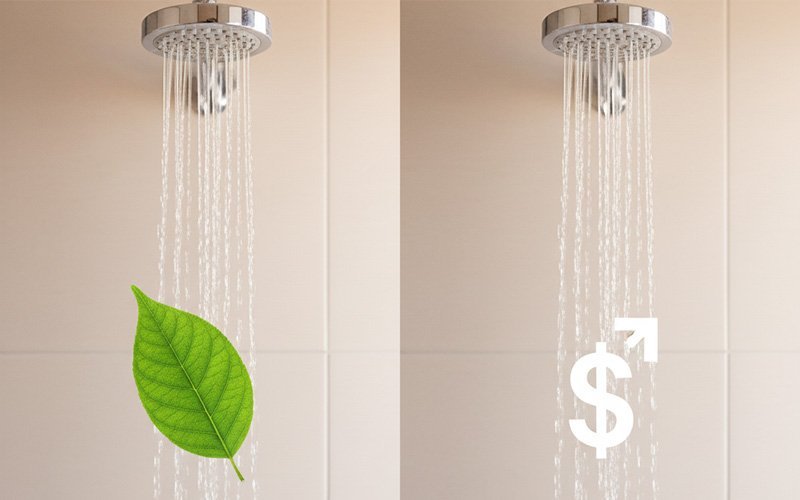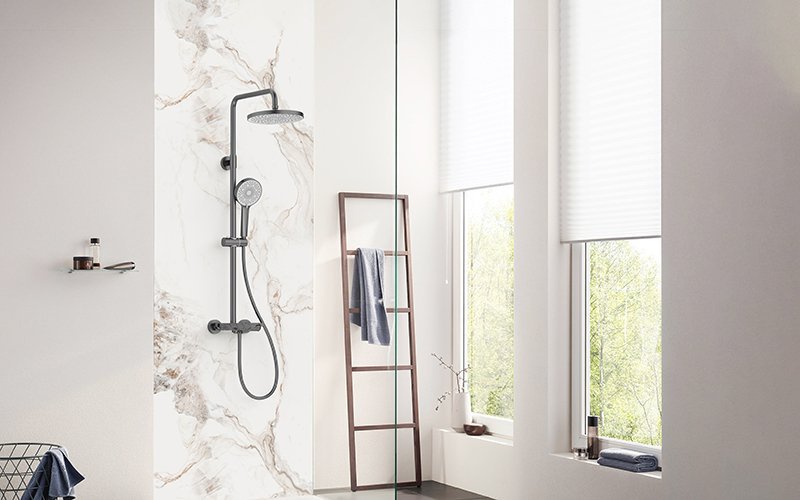Table of Content
- Understanding the Slide Bar Shower System
- Key Considerations for Selecting a Slide Bar System
- Shower Heads and Spray Patterns
- Installation Insights: DIY vs. Professional
- Long-Term Care: Maintaining Performance and Appearance
- Comparing Shower System Options
- Final Recommendations and Buyer’s Checklist
- Final Summary

Understanding the Slide Bar Shower System
The shower head with a slide bar is a fixture designed to offer a more adaptable shower experience compared to traditional, fixed shower heads. This system allows for vertical adjustment of the shower head’s height, catering to the different needs of individuals within a household.
By understanding its components and functions, a buyer can determine if this system is a suitable option for their bathroom.
Anatomy of a Slide Bar Shower System: Core Components
A shower head with a slide bar combines features of a handheld shower with the hands-free operation of a fixed shower head.1 The system is an assembly of several parts, each with a specific function.
- The Slide Bar: This is a vertical bar or track mounted to the shower wall. It provides a channel for the handheld shower head holder to be adjusted vertically, allowing users to set the water source at their preferred height.
- The Slider/Holder (Cradle): This is the adjustable bracket that moves along the slide bar and holds the handheld shower head. The adjustment mechanism can vary, with common types including push-buttons, levers, or tightening nuts that lock the holder in place. The cradle often rotates or pivots, allowing for further adjustment of the handshower’s angle.
- The Handheld Shower (Handshower): This is the detachable shower head, or “wand,” that delivers water. It is connected to the water supply via a flexible hose, allowing it to be used in two ways: docked in the holder for a hands-free shower, or removed from the cradle for manual, targeted rinsing.
- The Flexible Hose: This component connects the handshower to the water supply, enabling its handheld functionality. Hoses are typically 59 to 72 inches long and are constructed from materials like metal or PVC.
- The Wall Supply Elbow (Drop Ell): This is the plumbing fixture that provides the water connection point. It is a threaded outlet mounted on the shower wall to which the flexible hose attaches. In some retrofit applications, a shower arm diverter may be used, which attaches to the existing shower arm and provides outlets for both a fixed shower head and the handheld hose.
Advantages of Adjustability and Flexibility
The slide bar system offers solutions to the limitations of a conventional fixed shower head.8 Its design addresses a range of user needs, which can make the shower experience more comfortable and practical.
- Accommodates Different User Heights: A primary function is the ability to serve users of different heights. A fixed shower head is installed at a single height, which may be inconvenient for some individuals.8 A slide bar allows each person to position the handshower at a suitable height.
- Improved Accessibility: The system can contribute to a more accessible bathing environment. For individuals with mobility challenges or those who shower while seated, the ability to lower the handshower to a reachable height is a key feature for safety and independence.1 It can also be useful for individuals with limited reach.
- Practical Utility: The handheld wand can make it easier to perform tasks like rinsing shampoo from thick hair, bathing children, and washing pets.8 It can also be used as a tool for rinsing shower walls, doors, and tubs.
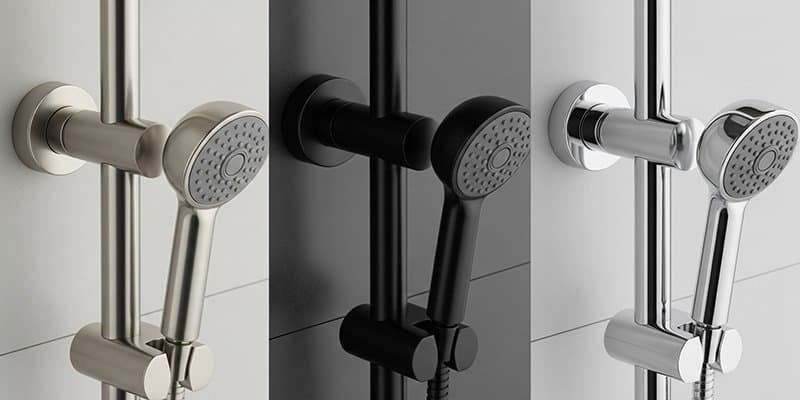
Key Considerations for Selecting a Slide Bar System
Choosing a slide bar system involves evaluating its physical attributes. The materials, finish, dimensions, and mechanical components are indicators of the product’s potential durability, ease of use, and long-term performance.
Material Analysis: Brass, Stainless Steel, and ABS
The choice of material affects a system’s quality, longevity, and price.
- Solid Brass: An alloy of copper and zinc, solid brass is known for its durability and resistance to corrosion and rust. Systems constructed from solid brass, including the bar, holder, and handshower, have a heavier feel. While it has a higher price point, solid brass is often chosen for its longevity.
- 304 Stainless Steel: This grade of stainless steel is another durable choice, known for its resistance to rust and corrosion in humid environments. It is frequently used for the slide bar, often paired with brass mounting brackets and holders.
- ABS (Acrylonitrile Butadiene Styrene): Often referred to as “engineering-grade plastic,” ABS is a durable, lightweight, and cost-effective material used for handshowers and, in some cases, the slider mechanism. While it does not have the weight of solid metal, ABS allows for feature-rich systems at a more accessible price point. A potential trade-off is a reduction in long-term durability compared to an all-metal build.
Finishes for Different Styles
The finish determines the fixture’s appearance and influences its maintenance requirements.
- Polished Chrome: A reflective surface that is easy to match with other bathroom hardware. It has a tendency to show water spots and fingerprints.
- Brushed & Satin Nickel: These finishes have a softer, low-sheen appearance that is effective at concealing water spots and fingerprints.
- Matte Black: A choice for contemporary and industrial designs, matte black is resistant to showing fingerprints and water spots. Its non-reflective surface can be more susceptible to scratching from abrasive cleaners.
- Oil-Rubbed Bronze: This dark finish provides a traditional look. Some oil-rubbed bronze fixtures have a “living finish,” meaning the color may change over time with use.
- Brass & Gold Tones (Polished, Brushed, Satin): These warm-toned finishes are a prominent trend. Traditional polished brass may require regular polishing to prevent tarnishing. In contrast, modern brass and gold finishes often utilize a Physical Vapor Deposition (PVD) process, which bonds the finish to the metal and is intended to be more resistant to scratches, corrosion, and tarnishing.
The combination of materials and finishes can affect the fixture’s resilience. For instance, a PVD finish on solid brass may offer a high level of durability, whereas a simple electroplated finish on ABS plastic will be a more budget-friendly but potentially less robust option.
Bar Dimensions: Length and Diameter
The physical dimensions of the slide bar are a key functional consideration. Standard lengths typically fall between 20 and 36 inches, with 24, 27.5, and 30 inches being common sizes.
- Functional Range: The length of the bar determines the range of vertical adjustment. A longer bar (30 inches or more) is suitable for households with a wide range of user heights or where seated showering is a necessity. A shorter bar of around 24 inches is often sufficient for many families and can be a better fit in smaller shower stalls.
- Diameter and Stability: The diameter of the bar, often 9/16 inch for standard models and up to 1-1/4 or 1-1/2 inches for heavy-duty versions, is an indicator of its robustness. A larger diameter is particularly important for combination slide bar/grab bar units, as it provides the necessary strength and grip surface to meet certain safety standards.
Slider Adjustment Mechanisms
The mechanism that allows the holder to move and lock into place impacts ease of use and reliability.
- Push-Button: This mechanism typically allows for one-handed height adjustment, making it a functional choice for children and individuals with limited hand strength.
- Lever/Locking Tab: This design requires the user to engage a lever or tab to release the locking mechanism, move the holder, and then re-engage the lever to secure it.
- Twist/Nut Tightening: This mechanism involves loosening a collar or nut on the holder to allow for movement and then tightening it to lock the holder in place. It can be more challenging to operate with wet hands.
- Hand Crank: A less common design, the hand crank offers a mechanical advantage for tightening the holder, which can help prevent it from slipping over time. This mechanism is often found on all-metal systems.
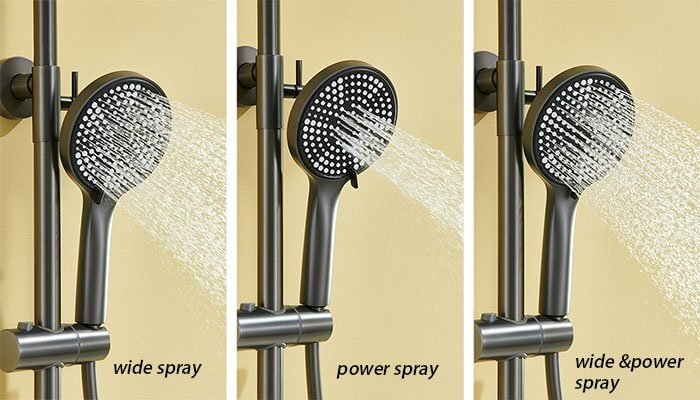
Shower Heads and Spray Patterns
The handshower is the component that delivers the water and determines the spray characteristics. Its design, spray patterns, and technology determine water pressure, coverage, and water efficiency.
Handshower Types, Shapes, and Sizes
Handshowers are available in a variety of forms to suit different functional needs and aesthetic preferences.
- Shape: The most common shape is the classic round spray face, which offers a balanced spray. For a more modern look, square and rectangular “wand” style handshowers are also popular.
- Size (Spray Face Diameter): The diameter of the spray face impacts water coverage. A larger face, such as one with an 8-inch diameter, can provide wider coverage, while a smaller face of 2.5 to 4 inches will deliver a more concentrated spray.
- Types:
- Standard Handshower: Suitable for general showering and utility tasks.
- Rain Shower Handshower: Some oversized handshowers are designed to emulate a rain shower experience with a wider, gentler spray pattern.
- Dual/Combo Units: These systems integrate a detachable handshower into the center of a larger, fixed shower head. This allows the user to run the fixed head, the handshower, or both simultaneously.
A Glossary of Spray Patterns
Multi-function handshowers offer a range of spray patterns that can be selected with a dial or button.
- Full/Wide Coverage: The standard, all-purpose setting that provides a broad, steady spray for everyday rinsing.
- Massage/Jet/Targeted: A powerful, often pulsating or concentrated stream of water used for targeted rinsing.
- Rain/Rainfall: A gentle, soft spray from a wider spray face, intended to mimic the feeling of a natural rainfall.
- Mist: A very fine, atomized spray that creates a cloud of vapor, offering a gentle sensation.
- Combination Sprays: Many shower heads allow users to combine patterns, such as a full-body spray with a central jet.
- Water-Saving/Pause: A feature that reduces the flow to a trickle. This is designed to conserve hot water while lathering or shampooing, without losing the temperature setting
| Spray Pattern | Characterization |
|---|---|
| Full Body / Wide Coverage | Everyday rinsing, complete and efficient coverage. |
| PowerSpray / Jet / Massage | A powerful stream for targeted rinsing and washing thick hair. |
| Rain / Rainfall | A gentle, drenching spray experience. |
| Mist / Nebulizing | Gentle cleansing for sensitive skin, creating a steamy atmosphere. |
| Pause / Water-Saving Trickle | Conserving hot water while lathering, shampooing, or shaving. |
Advanced Spray Technologies
Manufacturers have developed technologies intended to enhance the shower experience, particularly with water conservation in mind.
- Air-Induction Technology: This technology works by drawing air into the water stream within the shower head. This process infuses each water droplet with air, making the droplets larger and fuller. The intended result is a spray that feels like it has a higher flow rate while using less water.
- Droplet Sculpting Technology: This technology controls the shape and velocity of the water droplets. It sculpts water into a unique wave pattern, creating larger droplets that may retain heat longer. This allows the shower head to provide what feels like more coverage at the same flow rate.
- Pulsating Technology: This technology is engineered to modulate water flow to produce a powerful, pulsating spray.
WaterSense Certification
Water conservation is an important aspect of modern bathroom design, and the U.S. Environmental Protection Agency (EPA) WaterSense program provides a standard for identifying water-efficient products.
- The GPM Standard: Showering accounts for nearly 17% of residential indoor water use. Standard shower heads have a maximum flow rate of 2.5 gallons per minute (GPM). To earn the WaterSense label, a shower head must have a flow rate of no more than 2.0 GPM, and often as low as 1.8 or 1.75 GPM. These products must also pass independent testing for performance to meet criteria for spray intensity and coverage.
- The Intended Benefits: Choosing a WaterSense-certified model may provide three advantages:
- Water Savings: According to the EPA, an average family can save approximately 2,900 gallons of water annually.
- Energy Savings: Because less hot water is used, the demand on the water heater is reduced. The EPA estimates this can save over 370 kilowatt-hours of electricity per year for an average family.
- Cost Savings: These efficiencies can translate into lower water and energy utility bills.
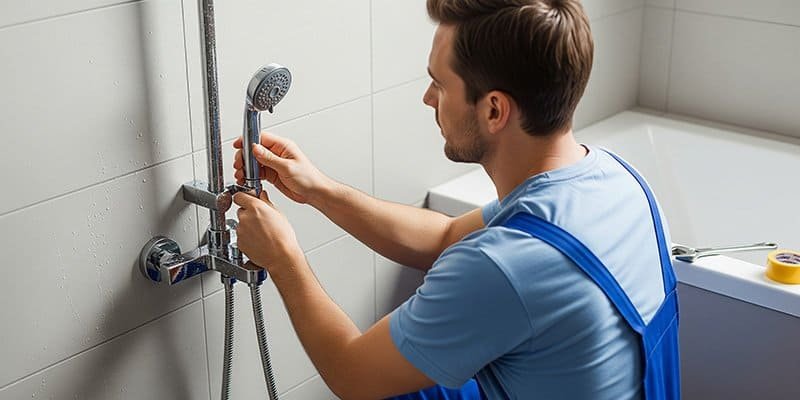
Installation Insights: DIY vs. Professional
The installation of a slide bar system is important for its function, safety, and longevity. While some installations can be straightforward, others present complexities. Understanding the process, the challenges posed by different wall surfaces, and the distinction between a slide bar and a grab bar will guide the decision between a do-it-yourself project and hiring a professional.
Preparation for Installation: Tools and Checks
Proper preparation is key to a smooth installation. The typical tools required include an adjustable wrench, screwdrivers, a power drill with appropriate bits, a tape measure, a pencil, and plumber’s (Teflon) tape.
Before beginning, the water supply to the shower must be turned off. The old shower head should be removed, and any old plumber’s tape and residue must be cleaned from the threads of the shower arm. One of the most critical steps is planning the location of the slide bar. A level must be used to mark the mounting holes to ensure the bar will be vertically straight.
Mounting Surfaces: Tile vs. Fiberglass
The material of the shower wall impacts the installation method.
- Tile and Marble Walls: Installing on a hard surface like ceramic tile or marble requires a specialized drill bit (e.g., a diamond-tipped or carbide-tipped bit) to prevent cracking. The process demands slow, steady pressure. A properly constructed tiled shower typically has a solid substrate behind the tile, such as a cement backer board, which provides a secure surface for wall anchors.
- Fiberglass and Acrylic Enclosures: These surfaces can present a challenge. Fiberglass shower stalls often have a hollow space between the enclosure and the wall studs. Drilling and tightening screws directly into unsupported fiberglass can cause it to flex or crack. To overcome this, installers must either confirm the presence of manufacturer-integrated wood backing or use specialized hardware, such as toggle bolts that pass through the fiberglass and open up in the hollow space behind it.
A Critical Distinction: Slide Bar vs. Grab Bar
This is a very important safety consideration during installation. A standard shower slide bar is engineered only to support the weight of the handshower.
It is not designed to support the weight of a person. In the event of a slip, grabbing onto a standard slide bar can cause it to pull out of the wall, potentially leading to injury.
- The Solution: ADA-Compliant Grab Bars: For homeowners who need the security of a grab bar, the solution is a combination unit. These products are engineered and tested to function as both a slide bar and an ADA-compliant grab bar. They feature a larger bar diameter and a more robust mounting system designed to withstand significant force.
- Secure Mounting: Wall Blocking: The most secure method for installing either a standard slide bar or a certified grab bar is to anchor it to solid wood blocking.10 Blocking consists of horizontal pieces of lumber installed between the vertical wall studs at the desired mounting height. This provides a solid wood target to screw into, creating a stronger connection than wall anchors. This step must be planned and completed during the construction or renovation phase, before the wall is finished.
DIY vs. Professional Installation
The decision to install the system yourself or hire a professional depends on the complexity of the job and your skill level.
- DIY Installation: The primary advantages are the savings on labor costs and scheduling flexibility. A straightforward retrofit onto an existing wall elbow in a fiberglass shower may be a manageable project for a confident DIYer. However, the risks include measurement errors or cracking a tile. Improper installation can lead to leaks, causing water damage behind the wall. Furthermore, some manufacturers may void the product warranty if it is not installed by a licensed professional.
- Professional Installation: The main drawback is the added labor cost. However, a professional has the experience and tools to handle challenges like drilling into tile or ensuring a watertight seal. They can also ensure that any necessary blocking is installed correctly for a secure mount. For complex installations or when installing a certified grab bar, professional installation is recommended.
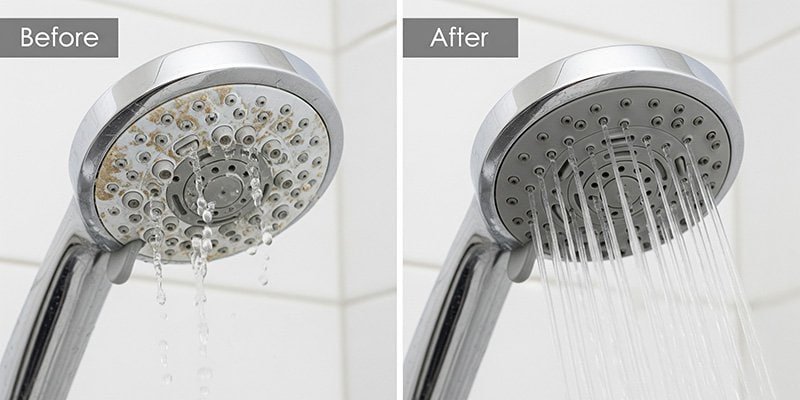
Long-Term Care: Maintaining Performance and Appearance
Proper long-term care is essential to ensure the system continues to perform well and maintain its appearance. The maintenance routine is primarily dictated by water hardness and the type of finish on the fixtures.
Combating Hard Water: Cleaning and Preventing Mineral Buildup
The most common issue affecting shower head performance is the buildup of mineral deposits (limescale), which can clog nozzles and reduce water flow.
- The Vinegar Soak: An effective method for descaling a shower head is to use distilled white vinegar. Fill a plastic bag with a 50/50 solution of white vinegar and warm water and secure it over the handshower with a rubber band, ensuring the nozzles are submerged. Allow it to soak for at least four hours. The acetic acid in the vinegar can dissolve the mineral deposits.
- Deep Cleaning: After soaking, use an old toothbrush to gently scrub away any remaining deposits. To clear blockages from individual spray holes, use a wooden toothpick or a straightened paperclip. For a more complete cleaning, the handshower can be unscrewed from the hose to clean the internal filter screen, where debris can collect.
- Hose Cleaning: The flexible hose can also be detached and soaked in a bucket filled with the same vinegar and water solution.
- Prevention: A quick wipe-down of the shower head nozzles with a soft cloth after each use can remove water droplets before they evaporate. For homes in areas with very hard water, installing a whole-home water softening system is an effective long-term solution.
Caring for Your Finish
Using the wrong cleaning products can damage the fixture’s finish. Avoid harsh, abrasive cleaners and steel wool.
- Chrome and Stainless Steel: These durable finishes can generally be cleaned with vinegar solutions.
- Matte Black and Oil-Rubbed Bronze: These finishes are more susceptible to surface damage. Clean them with mild soap and water or a heavily diluted vinegar solution. Always use a soft cloth to avoid creating shiny spots or scratches.
- Brass and Gold Tones: These finishes, especially if not PVD-coated, can be damaged by prolonged exposure to acid. For these surfaces, use a diluted vinegar solution and limit soaking times.
Routine Maintenance Checklist
A consistent maintenance schedule can help keep your system in optimal condition.
- Weekly: Wipe down the handshower nozzles, slide bar, and hose with a soft, dry cloth.
- Monthly: Inspect the spray pattern and scrub nozzles with a toothbrush if needed.
- Quarterly to Semi-Annually: Depending on water hardness, perform a full vinegar soak of the handshower and hose.
- Annually: Check hose connections for security and leaks.
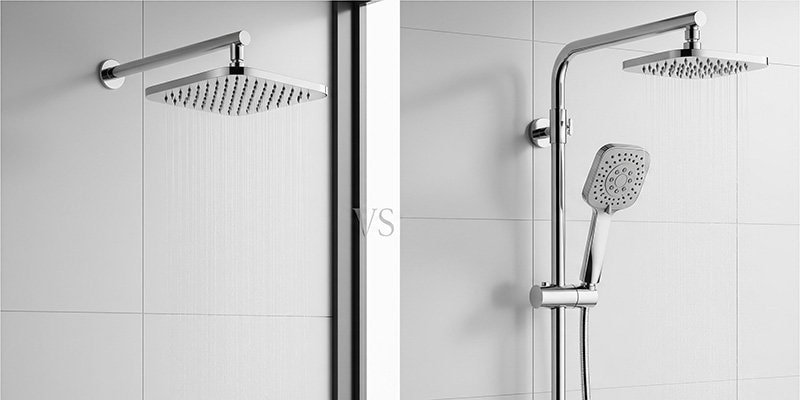
Comparing Shower System Options
To make an informed decision, it is helpful to understand how slide bar shower systems compare to other common options in the market.
Slide Bar vs. Fixed Shower Head
This is the most fundamental choice when selecting a shower head.
- Flexibility & Accessibility: The slide bar system offers adjustability for users of all heights and abilities. A fixed head is static.
- Aesthetics & Simplicity: Fixed shower heads can offer a cleaner, more integrated look than a system with a bar and hose.
- Installation: Replacing a fixed head with a new one is a simple DIY task. Installing a slide bar system is more involved, requiring drilling into the wall.
- Cost: A high-quality fixed shower head is generally more affordable than a complete slide bar system.
- Maintenance: With fewer moving parts, a fixed shower head is marginally easier to maintain.
Slide Bar System vs. All-in-One Shower Panel
For those considering a major upgrade, the shower panel is an alternative to a component-based slide bar system.
- Customization: A slide bar system allows for greater freedom to select the slide bar, hose, and handshower separately. A shower panel is a single, pre-configured unit.
- Features: Shower panels often include more features in one unit, such as multiple body jets and temperature displays.
- Installation: Shower panels are typically designed for surface-mounted installation over existing plumbing, making them a good option for retrofits that avoid extensive retiling. A custom shower system built around a slide bar may require more behind-the-wall plumbing work.
- Aesthetics: Shower panels have a distinct, modern appearance. Slide bar systems are more stylistically versatile and can be selected to match a wider range of decor.
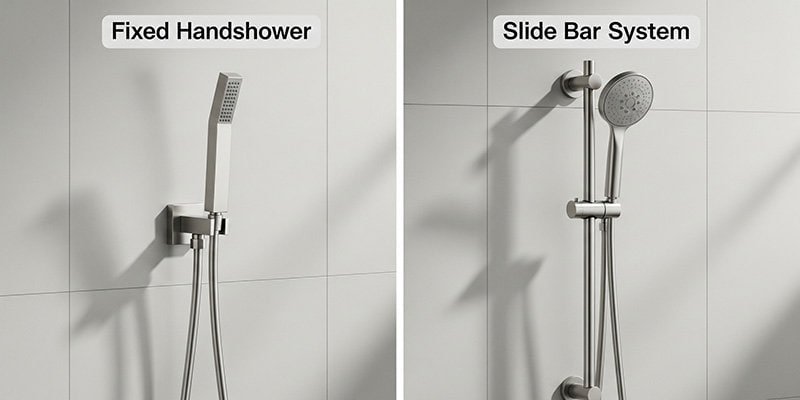
Final Recommendations and Buyer’s Checklist
Selecting a shower head with a slide bar involves aligning a product’s features with the practical needs of your household. The right system is one that provides a blend of functionality, durability, safety, and style for your bathroom.
Who is a slide bar shower system for?
This system is a suitable choice for a wide range of users, particularly:
- Families with Children: Allowing the shower height to be adjusted as they grow.
- Households with Multiple Users of Varying Heights: Eliminating the need for compromise.
- Individuals with Limited Mobility or Who Prefer Seated Showering: Providing safety and accessibility.
- Homeowners Seeking Practicality: Simplifying tasks like cleaning the shower and washing pets.
- Anyone Desiring a Customizable Shower Experience: Offering a variety of spray patterns and targeted rinsing.
Pre-Purchase Checklist
Before making a final decision, run through this checklist to ensure all key factors have been considered.
Feature Checklist
Use this list to compare specific models as you shop.
Final Summary
A suitable shower head with a slide bar is a system where every component works together to meet the demands of the user.
A successful purchase is the result of a process that prioritizes a secure installation, chooses materials and finishes appropriate for the home’s water quality and maintenance routine, and selects features that enhance the daily lives of those who will use it.
By investing time in this research, a homeowner can select a system intended to provide safety, comfort, and functionality.
Related Posts



